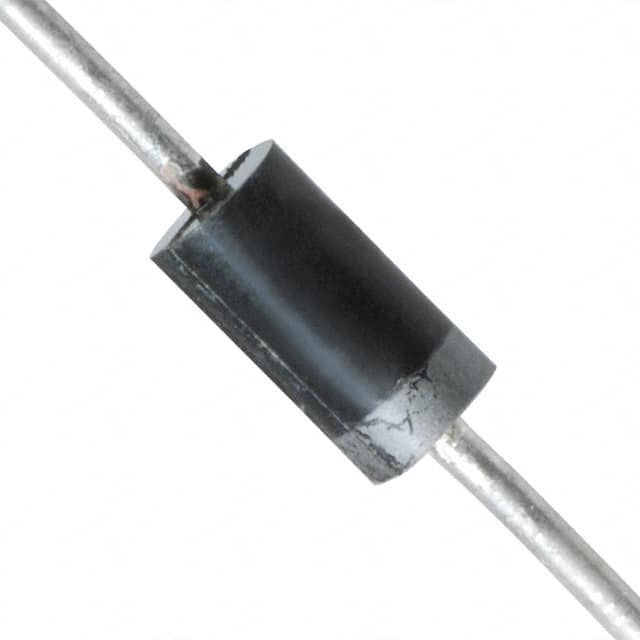1N4005-N-2-2-BP Encyclopedia Entry
Product Overview
The 1N4005-N-2-2-BP is a rectifier diode belonging to the category of electronic components. It is commonly used in various electronic circuits for its specific characteristics and functionality. This diode is known for its reliability, efficiency, and ease of use, making it a popular choice among electronic enthusiasts and professionals.
Basic Information
- Category: Electronic Components
- Use: Rectification in electronic circuits
- Characteristics: Reliable, efficient, easy to use
- Package: Standard diode package
- Essence: Essential for converting alternating current (AC) to direct current (DC)
- Packaging/Quantity: Typically available in reels or bulk packaging
Specifications
The 1N4005-N-2-2-BP diode has the following specifications: - Maximum Average Forward Current: 1A - Peak Repetitive Reverse Voltage: 600V - Forward Voltage Drop: 1V - Operating Temperature Range: -65°C to +175°C - Package Type: DO-41
Detailed Pin Configuration
The 1N4005-N-2-2-BP diode has a standard pin configuration with two leads. The anode is connected to one lead, while the cathode is connected to the other lead.
Functional Features
This diode serves as a unidirectional current flow device, allowing current to pass through it in only one direction. It efficiently converts AC to DC by blocking the reverse current flow.
Advantages and Disadvantages
Advantages
- Reliable rectification performance
- Low forward voltage drop
- Wide operating temperature range
Disadvantages
- Limited maximum average forward current
- Not suitable for high-frequency applications
Working Principles
The 1N4005-N-2-2-BP diode operates based on the principle of semiconductor junction behavior. When a positive voltage is applied to the anode with respect to the cathode, the diode conducts, allowing current to flow. In the reverse bias condition, the diode blocks the current flow.
Detailed Application Field Plans
The 1N4005-N-2-2-BP diode finds extensive use in various electronic applications, including: - Power supply units - Battery chargers - Voltage regulators - Rectifier circuits
Detailed and Complete Alternative Models
Several alternative models can be considered as substitutes for the 1N4005-N-2-2-BP diode, including: - 1N4001 - 1N4002 - 1N4003 - 1N4004 - 1N4006 - 1N4007
In conclusion, the 1N4005-N-2-2-BP diode is a fundamental component in electronic circuits, providing reliable rectification and essential functionality for various applications.
Word Count: 410
Sebutkan 10 pertanyaan dan jawaban umum terkait penerapan 1N4005-N-2-2-BP dalam solusi teknis
What is the maximum forward voltage drop of 1N4005-N-2-2-BP?
- The maximum forward voltage drop of 1N4005-N-2-2-BP is typically around 1V at a forward current of 1A.
What is the maximum reverse voltage rating of 1N4005-N-2-2-BP?
- The maximum reverse voltage rating of 1N4005-N-2-2-BP is 600V.
Can 1N4005-N-2-2-BP be used for rectification in power supplies?
- Yes, 1N4005-N-2-2-BP is commonly used for rectification in power supplies due to its high reverse voltage rating and low forward voltage drop.
What is the maximum average forward current rating of 1N4005-N-2-2-BP?
- The maximum average forward current rating of 1N4005-N-2-2-BP is 1A.
Is 1N4005-N-2-2-BP suitable for general-purpose switching applications?
- Yes, 1N4005-N-2-2-BP can be used in general-purpose switching applications due to its fast recovery time and low leakage current.
What is the typical junction capacitance of 1N4005-N-2-2-BP?
- The typical junction capacitance of 1N4005-N-2-2-BP is around 15pF at a reverse bias of 4V.
Can 1N4005-N-2-2-BP be used in surge protection circuits?
- Yes, 1N4005-N-2-2-BP is suitable for surge protection circuits due to its ability to handle high transient currents.
What is the operating temperature range of 1N4005-N-2-2-BP?
- The operating temperature range of 1N4005-N-2-2-BP is typically -65°C to +175°C.
Does 1N4005-N-2-2-BP have a high reverse recovery time?
- No, 1N4005-N-2-2-BP has a relatively low reverse recovery time, making it suitable for high-frequency applications.
Is 1N4005-N-2-2-BP RoHS compliant?
- Yes, 1N4005-N-2-2-BP is RoHS compliant, making it suitable for use in environmentally sensitive applications.


